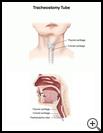
Tracheomalacia
What is tracheomalacia?
Tracheomalacia is a condition in which the walls of the windpipe (trachea) are very weak or soft. The windpipe is the airway that leads from the throat to the lungs. It is made of muscles and a tough flexible tissue called cartilage. Rings of cartilage support the windpipe and keep it open when you breathe. When a child has tracheomalacia, the windpipe may be so weak that it collapses and may block the airway.
What is the cause?
Tracheomalacia is most common in infants and small children. Most of the time it is a birth defect. It may also develop if your child has:
- A breathing tube in the throat for a long time
- An abnormal connection between the windpipe and the food tube that connects the throat to the stomach (esophagus) that puts pressure on the windpipe
- Severe and frequent heartburn, also called gastroesophageal reflux disease (GERD)
What are the symptoms?
Symptoms of tracheomalacia include loud noisy breathing and a loud barking cough. Your child may wheeze constantly. The wheezing may be worse when the baby cries, feeds, or coughs. Symptoms usually get better when the baby lies on his or her stomach or sleeps.
Most babies with this disorder seem happy and do not seem to be struggling when they wheeze. If tracheomalacia is severe, your child may struggle to breathe. Babies may not be able to breathe and eat at the same time and may not gain much weight.
How is it diagnosed?
Your child’s healthcare provider will ask about your child’s symptoms and medical history and examine your child. Tests may include:
- Laryngoscopy or bronchoscopy, which use a thin, flexible, lighted tube passed through your child’s mouth and down into the throat or lungs to examine your child’s airways
- X-rays or other scans
How is it treated?
Tracheomalacia usually gets better without medical treatment by the time a child is 6 to 12 months old and goes away by 24 months of age.
If the condition is severe, does not get better, or slows your child’s growth, your child may need:
- Continuous positive airway pressure (CPAP) machine. This is a machine that sends air into the child's airway through a special mask put on the face. The machine does not breathe for your child, but the pressurized air helps keep the airway open.
- Tracheostomy (also called a tracheotomy). This is a surgical procedure that makes a small opening in your child’s neck and windpipe. A tube is then placed in the opening to keep it open. Your child breathes through this tube rather than through the mouth and nose.
How can I take care of my child?
Children with this condition need to be carefully watched when they get colds or other respiratory infections because an infection can make their symptoms worse.
Follow your child’s healthcare provider's instructions for treatment. Ask your child’s provider:
- How long it will take for your child to recover
- If there are activities your child should avoid and when your child can return to normal activities
- How to take care of your child at home
- What symptoms or problems you should watch for and what to do if your child has them
Make sure you know when your child should come back for a checkup.
Last modified: 2017-04-11
Last reviewed: 2017-04-11

